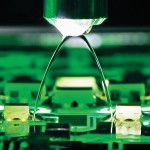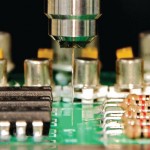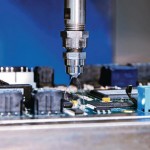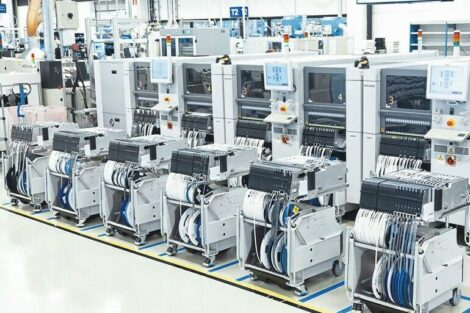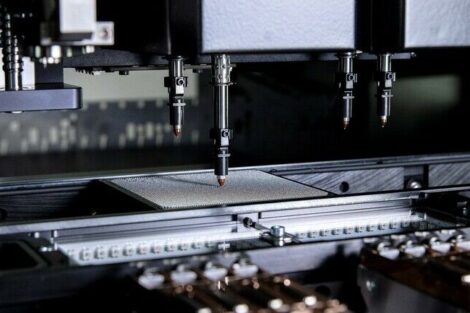Conformal coating is an enabling process that allows for the ruggedizing of electronic devices and modules. As the process increases the durability of electronics that are subjected to various end-use environmental conditions, it adds value to the product. While it does add value, consumers and manufacturers expect the electronics to work when subjected to dirt, humidity, moisture, corrosive materials, and various other contaminants. This expectation results in a drive to minimize the cost of the process. The lowest cost of ownership for a conformal coating process occurs by utilizing automated selective conformal coating equipment.
Brad Perkins, Nordson Asymtek, Carlsbad (USA)
Selective coating equipment, in contrast to broadcast spraying or dipping that require masking, only coats the needed regions of the board. The use of properly characterized automated equipment is a reliable way to increase yield, increase throughput, and reduce the cost of the conformal coating process. The cost can be further reduced and the speed increased through understanding the capabilities of the selective coating equipment and including those considerations at the design phase.
Selective coating
The conformal coating process provides surface level protection to the printed circuit assembly (PCA) and does not cover the entire circuit board as there are areas where coating is not applied, commonly referenced as keep-out zones. It prevents the circuitry from having a reduction in the surface insulation resistance that can cause shorts, arcing, and signal cross-transmissions. Because conformal coating is an electrically insulating material it is not applied to areas where electrical transmission is needed for the lifetime of the product; examples of this are test points and socket connectors. The coating also inhibits mechanical motion once it’s cured so it is not applied to mounting points, potentiometers, MEMS, or devices that are designed with a required motion component. Finally, because it is a coating, there are areas of the board where it is not applied because it affects the optical performance, as with displays and bar codes.
Coating is applied selectively to the board either through automated selective coating equipment or a masking process that is subsequently removed after cure. For moderate to high volume production, the lowest process cost of ownership comes when the coating is applied selectively through automated equipment. The masking process is done either through mechanical masks that create shadowed areas or by applying a masking material to the board and removing it after coating. Both of these have drawbacks to the process. Mechanical masks, commonly designed into a fixture, need to be cleaned frequently to remove build-up and still leave an area in the shaded region where low viscosity coatings can flow into the keep-out zones. In the case of masking material that is applied to the keep-out zones, there is zero value-add to the final product because it is removed after the coating is cured. Masking adds labor and material costs to the bill of materials (BOM) without adding value to the final product.
In contrast, selective conformal coating equipment applies coating only where it is needed. This eliminates the need for labor to mask/de-mask as well as the cost of the masking material itself. A complex board can require 3–10 minutes for the mask/de-mask process. The labor savings with selective coating is typically significant as is the volume of products produced in a shift. In addition, the manual masking process increases the opportunities for failure because of the additional board handling during the assembly phase. Selective coating equipment only has the initial capital equipment investment that is depreciated over the ten to fifteen year lifetime of the 24/7 capable equipment; the only significant reoccurring cost is that of the coating itself. Using automated equipment eliminates operator-to-operator variation, further increasing yield over manual processes.
Optimized process
For optimized coating processes, the conformal coating material and the equipment should be thought about collectively. Manufacturers commonly select a specific conformal coating based on the cured properties of the material. This is a logical first step as the conformal coating is in a cured state when the electronics are in their final use model; however, the material is applied in a liquid state that is subsequently cured by thermal, ultraviolet, moisture, and other solidifying processes. For a high yield process a manufacturer also needs to strongly consider the material’s liquid properties and to characterize the coating process in conjunction with the design phase to minimize the PCA layout while respecting process tolerances. An understanding of the specific material’s rheology allows for automated coating equipment selection and defining process capabilities.
When considering design for manufacturing, some of the specific properties to consider when selecting a conformal coating are the material’s viscosity, chemical composition and associated work time, and environmental considerations. The viscosity is important because it determines how the material will flow once applied to the board as well as the type of applicators used to dispense the material. Low viscosity coatings (typically less than 100 centipoise) can be applied with high speed, highly selective non-atomized film coating technologies that can offer keep-out zones less than 2mm in production. Higher viscosity coatings require the use of atomizing coating technologies that are slower in coating rate and have keep-out zones typically greater than 3mm. Jetting or needle dispensing technologies can be used to decrease the keep-out zones to the 1mm neighborhood and are generally used to precisely coat specific parts rather than for coating an entire board. The addition of a second coating valve to increase selectivity can decrease process throughput. Considering the need for conformal coating, applying the required process tolerances for the material, and evaluating conformal coating equipment and characterization at the design phase greatly aid in manufacturability. It makes the manufacturing process less difficult, time-consuming, and costly, and avoids having to use specialized equipment, applying additional conformal coating, or using masks after the fact due to unplanned for parts or areas that have zero tolerances.
The chemical composition is also very important as often materials have finite work times, commonly referenced as pot life, before the equipment must be cleaned to avoid curing inside the equipment. The presence of hazardous solvents is common, so consideration needs to be given regarding process controls and the environmental impact of these materials. This specifically applies to the health of the employees, potential for cross contamination to other processes, and ventilation of the vapors. Finally, the cure mechanism is determined by the material as well, be it acrylics, urethanes, silicones, or epoxies. The time to cure is related to the material itself, and automated equipment selection depends on the cure mechanisms of the specific material. To minimize the time to cure and the associated work in process as well as line length, designers need to look at the specific coatings and not the equipment.
With a view to equipment
A high reliability coating process occurs most efficiently when there is characterization of the equipment prior to introducing the final product. The equipment used to apply the conformal coating has numerous input parameters to optimize the process; some of these are the applicator selection, nozzle orifice size, pressure causing the fluid to flow, the transversing speed of the applicator, height of the applicator from the substrate, and the overlap of each pass, to name a few of the most critical. The output of these variable settings provides the coating thickness, repeatability, throughput, and defects, such as bubbles and voids.
The equipment used to cure the coating material also has input variables depending on the cure mechanism. For thermal cure materials these are typically the temperature of the oven, belt speed, temperature ramps, and for some materials, the humidity inside the oven. For UV cure materials they are the height of the UV lamp and the speed the board passes through the oven. The output of these variable settings, in conjunction with the material thickness, provides the throughput of the cured product as well as defects, such as incomplete cure or over cure defects. Through first characterizing the equipment capabilities, the manufacturer is able to best develop a high yield, maximum throughput process for the end product. There are variables associated with coating a specific board due to board topography, keep-out areas, surface wetting, cleanliness, moisture retention, and component placement. Decoupling the equipment characterization from the final product enables higher reliability coating processes in a shorter and less costly development timeframe. Shorter because it is a simpler process without confounding variables, and less costly because of engineering time-savings as well as reduced potential scrap product generated in process development. Each coating material has slightly different rheological characteristics. Understanding how those interact with the equipment input variables subsequently provides the best manufacturing processes.
The majority of manufacturers who have successful coating operations manufacture more than one product. With multiple products there is a need to develop a process that works with many different selectivity requirements. By initially developing a coating process that is end-product independent, it allows companies to introduce new products more quickly because each product is not a unique project.
Finally, the conformal coating process is a very dynamic process because there are many tolerances that are inherent to it. Some of these are associated with the acceptable limits of material viscosity variations, substrate surface energy affecting wetability, surface cleanliness, fixture tolerances, and the coating equipment’s own tolerances on volumetric dispensing. All of these processes can be characterized for high yield; however, it is advantageous to have a basic characterization process that can be referenced to have a standard to work from. The equipment can be selected to have closed-loop heaters to control the viscosity, software controlled pressure regulators to dynamically adjust the spray patterns based on closed-loop monitoring, fiducial recognition for increased placement accuracy, bar code scanners for automated program selection, and many additional options as defined by the process requirements.
Characterizing the equipment prior to introduction of the final product also helps to ensure that the initial process is defined in the center of the process window, allowing for the widest range of variation, which is much easier to do when it is defined outside of a specific product. It also decouples trouble-shooting issues from the incoming product (upstream issues) or issues with the coating process itself. This understanding minimizes the need for process support and increases the number of good parts being produced per shift. Automated selective coating equipment is very reliable and designed to run in 24/7 environments; the challenges are with the process itself. By considering the need for and type of coating at the design phase, and properly characterizing the equipment, helps ensure that the product can be manufactured utilizing automated equipment and at the lowest cost.
ZUsammenfassung
Die Beschichtung von Baugruppen in der Elektronikproduktion erhöht die Lebensdauer und somit den Wert eines Produktes. Doch auch beim Prozess einer Schutzlackierung ist das Zusammenspiel von Equipment und Prozess von Bedeutung, um den hohen Qualitätsanforderungen sowie steigenden Kosten gerecht zu werden, wie aus dem Artikel ersichtlich.
Le revêtement des modules dans la production électronique augmente la durée de vie et donc la valeur d’un produit. L’action conjuguée de l’équipement et du processus est importante dans le processus d’une peinture protectrice afin de répondre à des critères de qualité élevés et à l’augmentation des coûts. Pour plus d’informations lisez l’article.
Share:




